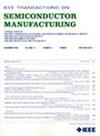Modeling the Energy Consumption of Integrated Circuit Fab Infrastructure
IF 2.3
3区 工程技术
Q2 ENGINEERING, ELECTRICAL & ELECTRONIC
引用次数: 0
Abstract
The bottom-up assessment of environmental impact of the fabrication of integrated circuit chips relies on accurate modeling of the operation of a high-volume semiconductor fab. In our virtual fab model, we structure fab operation in three concentric sectors: the wafer processing equipment, the generation of utilities that feeds the equipment, and the fab infrastructure that provides a suitable environment for the equipment and the workers. In this paper, we first address the correlation between process flow, wafer demand and fab dimension, which sets the scale of the virtual fab and enables global fab energy consumption estimates. Next, we describe how energy consumption calculations are performed sector-by-sector and how these evolve over the deployment of successive generations of logic nodes. In particular, we propose an original bottom-up model for fab infrastructure energy consumption that takes into account local climate dependence of a fab’s geographical location. The essence of these learnings is condensed into a normalized power consumption per manufacturing area (in kW/m2) that is deduced from our models as a function of technology maturity and location. These values form a good comparison basis with data from industry and literature.集成电路制造基础设施能耗建模
自下而上地评估集成电路芯片制造对环境的影响,有赖于对大批量半导体工厂运作的精确建模。在我们的虚拟工厂模型中,我们将工厂的运行分为三个同心圆部分:晶圆加工设备、为设备供电的公用设施以及为设备和工人提供合适环境的工厂基础设施。在本文中,我们首先讨论了工艺流程、晶圆需求和工厂规模之间的相关性,从而确定了虚拟工厂的规模,并实现了全球工厂能耗估算。接下来,我们介绍了如何逐个部门进行能耗计算,以及这些计算如何随着连续几代逻辑节点的部署而演变。特别是,我们提出了一种自下而上的工厂基础设施能耗原创模型,该模型考虑到了工厂地理位置对当地气候的依赖性。这些经验的精髓浓缩为每个制造区域的归一化能耗(单位:千瓦/平方米),该能耗是根据我们的模型推导出来的,是技术成熟度和地理位置的函数。这些数值是与行业和文献数据进行比较的良好基础。
本文章由计算机程序翻译,如有差异,请以英文原文为准。
求助全文
约1分钟内获得全文
求助全文
来源期刊

IEEE Transactions on Semiconductor Manufacturing
工程技术-工程:电子与电气
CiteScore
5.20
自引率
11.10%
发文量
101
审稿时长
3.3 months
期刊介绍:
The IEEE Transactions on Semiconductor Manufacturing addresses the challenging problems of manufacturing complex microelectronic components, especially very large scale integrated circuits (VLSI). Manufacturing these products requires precision micropatterning, precise control of materials properties, ultraclean work environments, and complex interactions of chemical, physical, electrical and mechanical processes.
 求助内容:
求助内容: 应助结果提醒方式:
应助结果提醒方式:


